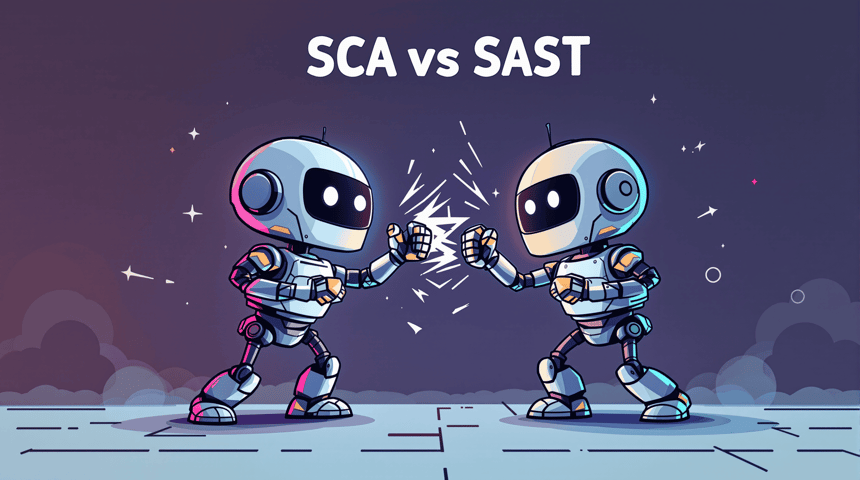SAST vs. SCA: Which Tool Should You Start With for Your AppSec Program?

In a perfect world, security teams would have all the tools, all the visibility, and all the resources they could possibly need. In the real world, though, security is all about tough choices. Starting a new AppSec program typically starts by deploying one tool at a time … but what tool maximizes the impact of your new AppSec initiative?
It’s not an easy question. In this article, we’ll explore the answer, but let’s start with a spoiler:
TL;DR: If you have to make the choice between SAST and SCA, start with SAST—it provides more immediate and actionable results.
Key Difference #1: Coverage & Control
Coverage acts as the fundamental difference between SAST and SCA approaches. SCA products identify vulnerabilities in third-party, open-source dependencies. Frequently, these tools claim to be more important than SAST due to code volume alone, due to the fact that up to 80% of the lines of code in a typical code base come from open-source dependencies.
On the other hand, SAST tools analyze security flaws in proprietary code written by your own developers. While it’s true that first-party code typically represents a smaller number of overall lines in the code base, it’s not exactly an apples-to-apples comparison: a huge amount of the code analyzed by SCA tools (and a high proportion of those tools’ findings) belong to libraries and functions that are never called by the actual application.
These coverage differences drive another contrast between SAST and SCA products: the capability to control and fix vulnerabilities. Most SCA findings pertain not to direct dependencies (where your developers may be able to implement a quick patch or version update and fix the problem fast), but to indirect dependencies—where one piece of open-source software calls upon another. In these circumstances, the only fix possible often involves waiting for the maintainers of every dependency in the tree to make security updates.
Because SAST findings pertain to code you have control over, it’s generally at least possible that your developers can actually fix the issue. SCA offers no such guarantees, and can generate a significant backlog of false positives and unfixable findings.
Key Difference #2: Higher ROI & Faster Wins
When you’re starting up an AppSec program, you need to be able to measure your results and demonstrate your security team’s effectiveness. SCA findings often include a huge number of issues that would be impossible (or nearly impossible) for an attacker to actually exploit in a real-world context—many CVEs have no known exploits, require physical access, or use complicated exploit methodology that may not be applicable to your environment.
SAST tools, however, focus on the highest-severity issues that have the greatest potential to cause harm. Issues like hard-coded credentials or improper handling of sensitive data can pose critical—or even existential—threats to organizations and their missions.
Any organization starting a new AppSec program from scratch will see a glut of findings from any tool the first time it’s turned on. By finding real vulnerabilities with potential for developers to remediate right away, SAST offers a better choice of “low-hanging fruit.” Fixing these high-severity issues right away generates immediate ROI and better helps executives to understand the value of AppSec initiatives.
Key Difference #3: Improving Code Quality
When considering the long-term sustainability of your AppSec program, developers and code quality matter—a lot. So which tool will give you the better approach to improving code quality over the long term?
SCA tools can be a good way to understand security hygiene practices, and there are certainly security lessons that can be learned from SCA tools. Most AppSec leaders can tell tales about finding dependencies that were five years (or even a decade) out of date, often with a slew of known vulnerabilities. But the main lesson of SCA is relatively simple: keep your dependencies up to date.
SAST findings represent a unique opportunity to help developers improve their code. By indicating the specific lines of impacted code and its reason for flagging the code, SAST tools can work to train developers in how to fix security holes and write more secure code over time. Developers can more easily identify the most common flaws in their own code, enabling a more tailored focus on self-improvement.
Have to Pick One? Make it SAST
Eventually, a mature security program will include tools to analyze both first- and third-party code. When you’re just getting started, though, SAST offers the potential for bigger wins, better ROI, more effective coverage, and improved code quality.
When you’re ready to power up your SAST findings with automated, AI-based precision fixes, Amplify can help—it’s a great way to rapidly work through your SAST findings and start generating ROI that gets noticed. Contact us today to see how we can help you resolve more SAST tickets and mitigate your application risk faster than ever before.
Subscribe to Amplify Weekly Blog Roundup
Subscribe Here!
See What Experts Are Saying
BOOK A DEMO

Jeremiah Grossman
Founder | Investor | Advisor

Saeed Abu-Nimeh
CEO and Founder @ SecLytics
Kathy Wang
CISO | Investor | Advisor.jpg?width=1200&height=1600&name=IMG-20210714-WA0000%20(1).jpg)